How to properly store potatoes without a cellar in the ground until spring
Some farmers are faced with the following problem: having harvested an unexpectedly rich potato harvest, they realize that all There is simply nowhere to store the volume of vegetables. However, it is not necessary to have a barn or cellar to store potatoes. There are other ways to ensure the safety of tubers.
We will tell you in detail in this article how to keep potatoes in the ground until spring without a cellar and how to make a pile for storing potatoes.
Optimal conditions for storing potatoes
To preserve the crop throughout the winter and avoid rotting, potato tubers are provided with special conditions.
Optimal storage temperature – +2…+4°С in winter. Air humidity should be no higher than 85%. If the temperature regime is not observed and the storage location is much colder, then the potato tubers freeze and acquire an unpleasant sweetish taste.
It is also important that the potatoes are not exposed to direct sunlight. This has a detrimental effect: in the sun, solanine, a toxic substance, is produced in the tubers, and the potatoes themselves acquire a greenish tint.
Is it possible to store potatoes in winter without a cellar in the ground?
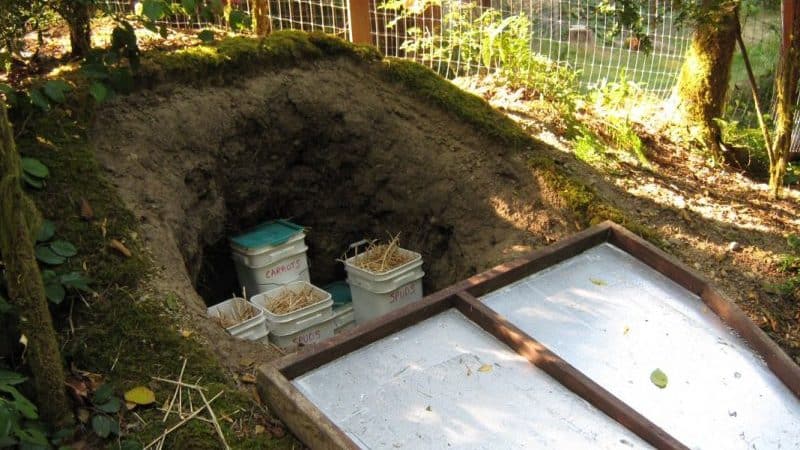
Storage in the ground is an alternative to a conventional cellar. An improvised cellar, subject to all construction rules, will provide similar conditions for potatoes.
Pros of underground storage:
- savings - such storage does not require a special room, you do not need to buy additional boxes or baskets;
- ease of transportation - storage can be ensured in the same place where the potatoes grew;
- simplicity - creating a pit does not require special skills;
- protection - with this method, small rodents and other pests will not be able to get to the potatoes.
Minuses:
- labor intensive - creating a hole requires significant effort;
- possible inaccessibility - in winter, such a “warehouse” can be heavily covered with snow from above, which will make access to the harvest problematic.
Storage mode in the ground
The temperature range for potatoes is quite wide: +2…+12°С. Storage in the ground is the best way: the ground will provide the crop with the necessary heat; in winter the temperature will remain around +3°C.
Advice. You can put beet tubers on top of the potatoes. Beets are not afraid of freezing and will absorb excess moisture.
The earthen storage facility is covered to prevent precipitation in the form of rain and snow and direct sunlight from entering the pit.
Potato varieties suitable for such storage
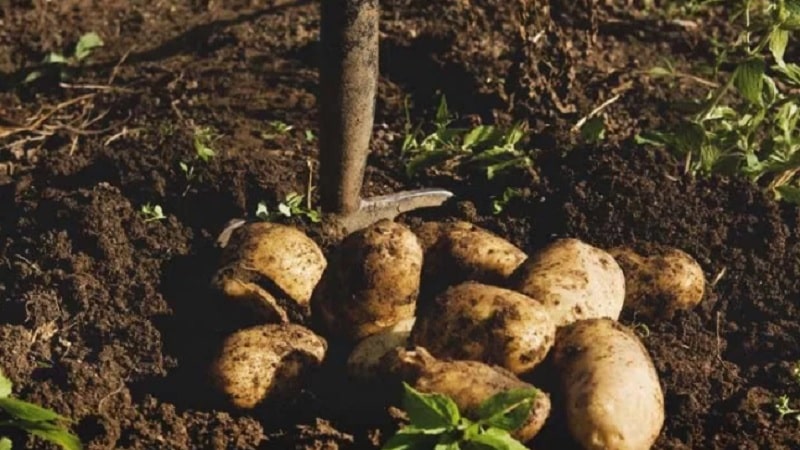
Even a prepared earthen pit that provides all the necessary conditions does not guarantee that the crop will last the entire winter and will not deteriorate. It's all about the potato varieties. Not all potatoes are suitable for long-term storage.
Early varieties are stored in any way for no more than 2 months. These include Aurora, Mistress, Rocco, Peter's Mystery and others.
Late Potato varieties do not cause problems and lie in an equipped storage until next spring. These include Zhuravinka, Atlant, Gull, Slav and others.
Reference. The Scarlett and Nevsky varieties are not late varieties, but they are stored well all winter.
Preparing potatoes for storage
Potatoes are prepared before storage. At the digging stage, the tubers are carefully removed from the ground so as not to damage them, since specimens with defects are stored much worse. Before storing in an earthen pit, the potatoes are sorted.
If the storage location is remote, then the potatoes are carefully transported so that the tubers do not hit each other. If the “cellar” is located near the digging site, the tubers are cleared of soil and thoroughly dried before immersion.
Important! To prevent rotting from affecting the crop in storage, potatoes are pre-treated with infusions of wormwood and tobacco. You can also spray the tubers with a solution of copper sulfate and dry.
How to store potatoes if there is no cellar
There are many different ways to store potatoes in winter: in the ground, cellar, basement, on the balcony. One of the oldest and most effective is storing potatoes in the ground. All necessary conditions for temperature and humidity are created in the soil to ensure high-quality storage.
There are also several ways to store it in the ground: in a hole, trench or pile. By creating such a storage facility, you can save the harvest until spring.
Important! It is recommended to periodically sort through the harvest sent for storage in order to weed out good potatoes from damaged tubers. If this is not done, then even one low-quality potato can cause massive rotting of the entire crop.
Pit storage
How bury potatoes for the winter into the ground? A pit is a simple storage for potatoes, equipped directly in the ground. A hole of the required size and depth of 0.7-1.5 m is dug on a plot of land. The depth depends on the region of residence and the severity of the frost, that is, on how much the ground freezes.
The bottom of the pit is lined with boards so that the tubers do not lie on bare ground.The top of the pit is also covered with boards, sprinkled with a layer of earth and covered with materials with thermal insulation properties - for example, straw or sawdust.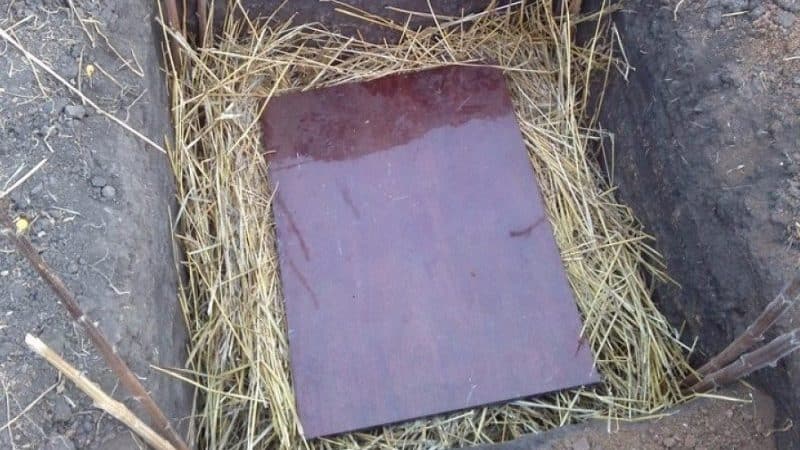
Often such improvised cellars are equipped with ventilation. Before forming the roof of the pit, a plastic pipe is inserted inside to ensure air exchange.
Important! The top of the ventilation pipe must be protected from precipitation or possible blockages.
Storage in trenches and piles
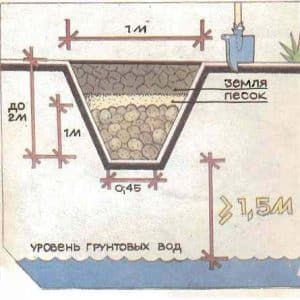
These methods are based primarily on the properties of the soil. Insufficient thermal conductivity and gas exchange in the soil create optimal conditions (temperature, humidity level) in trenches and piles to preserve the quality of the crop.
The dimensions and depth of such storage facilities, similar to a pit, depend on geographic latitude. The harsher the winter, the deeper the trenches and piles are dug.
In southern latitudes, trenches are more often used for storing potatoes, cabbage, and beets. Burts are more common in the north. Not only potatoes are left there for the winter, but also carrots, cabbage, beets, celery and other vegetables.
Burt with your own hands
Such method involves storing the crop directly on the ground and creating a protective layer on top. They try to place the pile in a place protected from cold winds with a groundwater level no closer than 2 m from the laying site.
To protect the collar from water leakage, drainage channels are made along the perimeter of the storage facility. To prevent autumn and spring surface water from stagnating at the storage site, drainage ditches are dug at a distance of 50 cm from the shelter.
The tubers are stacked in the form of a pyramid no more than 1.5 m high. The potatoes are covered with insulation (straw) on top, which is sprinkled with a layer of earth. It is important that the layer of earth at the edges is thicker than at the top of the pile.
DIY trench
A trench is dug of any length, no more than 1 m wide and 0.7 to 1.5 m deep, depending on the degree of freezing of the ground. They make a trench on a hill so that the crop does not flood.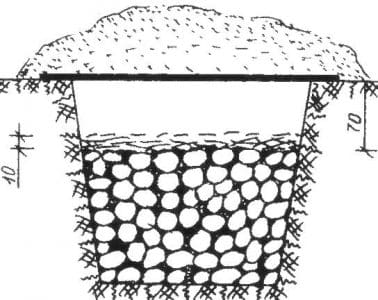
After the tubers are lowered into the trench, they are covered with heat-insulating material: spruce branches, straw, sawdust. This layer reaches the edges of the trench. The top of the trench is sprinkled with a layer of earth 0.3-0.4 m.
Storage in a trench does not require additional ventilation, since there will be more than enough oxygen in the soil.
Tips and tricks
Experienced gardeners who use earthen storage for potatoes recommend:
- cover vegetables with straw and soil in 2 stages - first with a thin layer to remove excess moisture, and then with another layer when cold weather sets in;
- do not use potato tops for covering - this can lead to tuber disease;
- in spring, dump snow from the pile so as not to flood the crop in case of sudden warming;
- After the tubers are completely removed in the spring, dig up the soil in the hole to a depth of 30 cm and disinfect it with a 5% solution of copper sulfate.
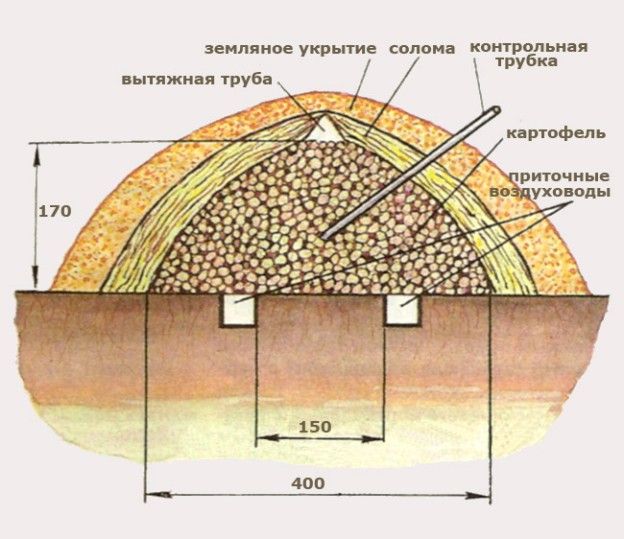
Conclusion
Storage in the ground will protect the crop in case of absence cellars. No special skills or tools are required to make a potato pit or trench. A plot of land is sufficient to equip such a storage place. In terms of its characteristics (humidity level, temperature), an earthen shelter is in no way inferior to a classic cellar.
When creating such a storage facility, it is important to take into account the depth of freezing of the ground and the possibility of groundwater leakage. Be sure to take care of the heat-insulating layer and periodically sort through the potatoes to remove spoiled tubers from the total mass.
Everything said is nonsense! Doesn't stand up to criticism. A collection of truisms not confirmed by practice